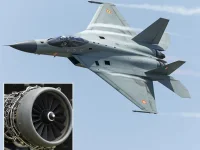- Views: 2K
- Replies: 16
A Japanese strategic analysis group has proposed a significant strengthening of defence ties between India and Japan, suggesting the joint development of a tactical strike system with a range of 2,000 to 3,000 kilometres.
This initiative, outlined in a recent report, aims to create a "shared deterrence" capability designed to counter China's increasing military power and influence in the Indo-Pacific region.
The report notes that while the United States possesses long-range strike options like Tomahawk cruise missiles and strategic bombers, a collaborative Indo-Japanese project could significantly alter the regional security balance. Such a system could potentially draw upon the technological experience gained from India's Agni missile program and Japan's Type-12 missile development.
The call for joint development stems from pressing strategic concerns shared by both nations. China's rapid military build-up, including advanced hypersonic missiles and an expanded naval footprint, presents challenges across the region.
Japan faces direct pressure concerning the disputed Senkaku Islands, while India continues to manage tensions along the Line of Actual Control (LAC) in the Himalayas, highlighted by the 2020 Galwan Valley incident.
The think tank argues that a joint long-range strike capability would provide both Tokyo and New Delhi with the means to threaten key Chinese military installations, thereby strengthening their deterrent posture without solely depending on American military support.
A strike range reaching up to 3,000 kilometres is considered strategically vital. For Japan, it would enable targeting deep within mainland China from its own territory or maritime platforms, bypassing coastal defences.
For India, such a range would cover crucial infrastructure in China's western and southern theatres, adding another layer to its existing ballistic missile capabilities, like the Agni series which includes variants reaching up to 5,000 km.
The report suggests that combining these capabilities would establish a more resilient, networked deterrence that could compel Beijing to reconsider potential aggressive actions.
While the US maintains significant long-range strike power, the Japanese report emphasizes that an Indo-Japanese partnership would distribute the responsibility of maintaining regional stability. This aligns with the concept of "integrated deterrence," where allies combine their resources to present a more complex challenge to potential adversaries, reducing reliance on any single nation, including the United States.
This proposal comes against the backdrop of China's own advancements, such as the DF-26 intermediate-range ballistic missile (often called a 'carrier killer' with a reported range around 4,000 km) and its well-established anti-access/area-denial (A2/AD) strategy aimed at preventing enemy forces from operating near its territory.
For India and Japan, developing conventional long-range strike options offers a credible deterrent capability that stops short of nuclear escalation, providing a response tool for various contingencies.
Both nations are already taking steps to enhance their strike ranges independently. Japan formally adopted a National Security Strategy in late 2022 that includes acquiring "counterstrike capabilities," leading to plans to procure Tomahawk missiles and significantly upgrade its indigenous Type-12 surface-to-ship missile for longer range land-attack roles (potentially up to 1,000-1,500 km).
India has its own programs, including the subsonic Nirbhay cruise missile (around 1,000 km range) and ongoing work on more advanced long-range systems. The think tank's vision represents a substantial leap beyond these current efforts, advocating for joint development to achieve the ambitious 3,000 km target.
Technologically, a partnership could blend Japanese expertise in precision manufacturing and advanced materials with India's established experience in developing cost-effective missile systems. Potential platforms could include advanced cruise or hypersonic missiles deployable from land, air, or sea, potentially including Japan's Izumo-class helicopter carriers or India's submarine fleet.
Operationally, realizing "shared deterrence" would necessitate close coordination in targeting strategies and extensive intelligence sharing, possibly involving frameworks like the Quad (India, Japan, Australia, US) or trilateral cooperation with the US. Such collaboration could allow coordinated threats against PLA assets from multiple directions, potentially undermining China's A2/AD network by stretching its defensive resources over a wider area.
However, significant hurdles exist. Japan faces constitutional limitations on offensive military capabilities under Article 9, although recent policy shifts have allowed for greater flexibility regarding counterstrike abilities.
Public opinion and political consensus remain important factors. India must weigh the benefits of deeper alignment against its long-standing policy of strategic autonomy.
Furthermore, the substantial financial investment required for developing and deploying such advanced systems presents a challenge, alongside the technological complexities involving propulsion, guidance systems, and the necessary intelligence, surveillance, and reconnaissance (ISR) infrastructure.
Despite these challenges, the proposal underscores a growing strategic convergence between India and Japan. Existing bilateral defence cooperation, evident in joint military exercises like Dharma Guardian (Army) and Malabar (Navy, often including the US and Australia), provides a foundation.
A shared strike capability would represent a major evolution, transforming the relationship into a more potent strategic partnership aimed at upholding a "free and open Indo-Pacific" and countering regional instability.
While some may view it as potentially escalating regional tensions, proponents argue that credible deterrence is essential for stability, providing a conventional means to discourage aggression without resorting to nuclear options.



